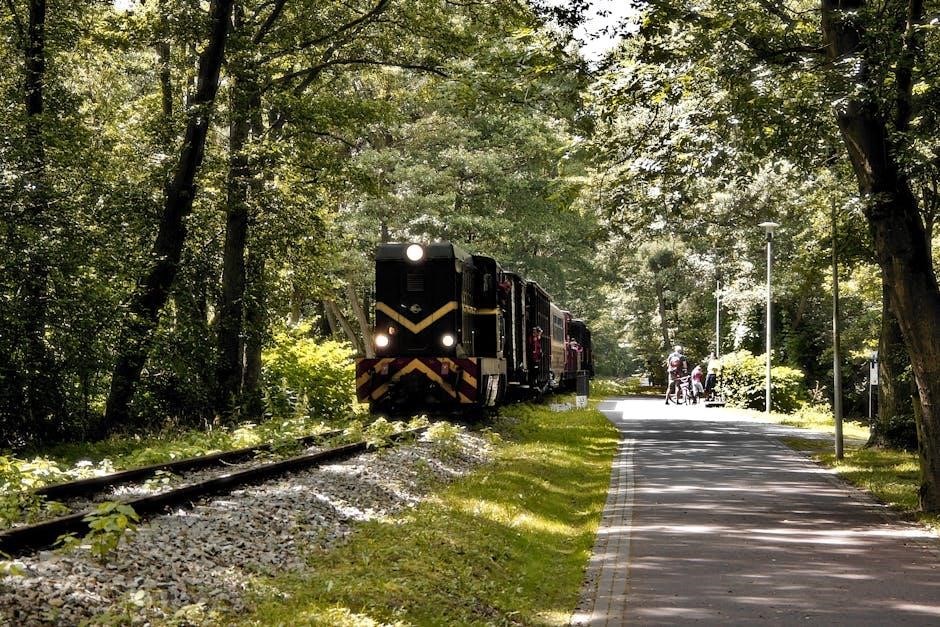A guiding track is a system designed to direct movement or alignment, ensuring efficiency and safety in transportation and industrial applications. Its purpose is to provide stability and precision, enabling smooth operation across various terrains and conditions. Historically, guiding tracks have evolved from simple alignments to sophisticated systems integrated with advanced technologies. Today, they play a critical role in modern infrastructure, supporting industries like rail, logistics, and urban planning. Understanding their design, functionality, and maintenance is essential for optimizing performance and sustainability in diverse operational environments.
1.1 Definition and Purpose of Guiding Track
A guiding track is a system or structure designed to direct the movement or alignment of vehicles, machinery, or other movable objects. Its primary purpose is to ensure efficient and safe movement by providing a stable path or reference point. Guiding tracks are essential in transportation systems, industrial applications, and logistics, where precise alignment and stability are critical. They minimize the risk of accidents, reduce wear and tear on equipment, and optimize operational performance. Their versatility makes them indispensable in modern infrastructure development and maintenance.
1.2 Historical Evolution of Guiding Track Systems
The concept of guiding tracks dates back to ancient civilizations, where stone or wooden pathways were used to direct carts and chariots. Over time, these primitive systems evolved into more sophisticated structures, particularly during the Industrial Revolution, when metal tracks became essential for railways. The 20th century saw the development of highway systems with concrete and asphalt tracks, enhancing road safety and efficiency. Modern guiding tracks now incorporate advanced materials and technologies, reflecting a continuous adaptation to technological and infrastructural needs.
1.3 Importance of Guiding Track in Modern Infrastructure
Guiding tracks are indispensable in modern infrastructure, ensuring efficient movement and alignment in transportation, logistics, and industrial systems. They enhance safety by reducing accidents and wear on vehicles, while improving operational efficiency. In railways, highways, and airports, guiding tracks provide precise navigation, enabling smooth traffic flow. Their role in load distribution and stability is critical, particularly in challenging terrains. As infrastructure advances, guiding tracks remain a cornerstone, supporting global connectivity and economic progress through reliable and durable systems.

Design and Construction of Guiding Track
The design and construction of guiding tracks involve careful planning, precise engineering, and the use of high-quality materials to ensure durability and safety. Factors such as terrain, load capacity, and environmental conditions significantly influence the design process, requiring tailored solutions for optimal performance and longevity.
2.1 Key Components of Guiding Track
The guiding track consists of several essential components, including the base foundation, track surface, alignment system, support structures, and sensors. The base foundation ensures stability, while the track surface provides the contact point for vehicles or machinery. Alignment systems maintain precision, and support structures reinforce the track’s integrity. Sensors monitor conditions in real time, enhancing safety and efficiency. These components work together to ensure smooth operation, durability, and adaptability to various operational demands, making them integral to the system’s functionality and reliability.
2.2 Materials Used for Guiding Track Construction
The construction of guiding tracks utilizes durable materials to ensure longevity and performance; Steel is commonly used for its strength and flexibility, while concrete provides a sturdy base. Composite materials are employed for their resistance to wear and tear. Rubber and plastic components are incorporated for noise reduction and lightweight applications. Advanced materials like fiber-reinforced polymers are also used for specialized tracks. The choice of material depends on the intended use, environmental conditions, and load-bearing requirements, ensuring optimal functionality and sustainability.
2.3 Advanced Construction Techniques
Modern guiding track construction employs advanced techniques to enhance precision and durability. Automation and robotics are increasingly used to optimize track alignment and reduce human error. Laser-guided systems ensure accurate installation, while 3D printing enables rapid production of custom components. Modular construction methods allow for faster assembly and reduced waste; These techniques, combined with real-time monitoring tools, improve efficiency and safety. They also enable the creation of adaptive tracks that can withstand varying environmental conditions, ensuring long-term performance and reliability in demanding applications.

Types of Guiding Tracks
Guiding tracks are categorized into permanent, temporary, and specialized types. Permanent tracks are installed for long-term use, while temporary tracks are designed for short-term applications. Specialized tracks cater to unique environments or specific operational needs, ensuring versatility and adaptability in various scenarios.
3.1 Permanent Guiding Tracks
Permanent guiding tracks are durable, long-term solutions designed for consistent use in high-traffic or critical applications. Constructed from robust materials like steel or concrete, they offer stability and reliability over extended periods. These tracks are commonly used in rail systems, industrial facilities, and infrastructure projects where precise alignment is essential. Their low maintenance requirements and ability to withstand harsh conditions make them a preferred choice for permanent installations. Permanent tracks ensure operational efficiency and safety by providing a consistent guiding mechanism in demanding environments.

3.2 Temporary Guiding Tracks
Temporary guiding tracks are versatile solutions used for short-term projects or dynamic environments where adaptability is crucial. They are often employed in construction zones, event setups, or emergency response situations. Made from lightweight yet durable materials, these tracks can be easily installed and removed without causing damage. Temporary tracks provide flexibility, allowing for quick adjustments and reconfigurations as needed. Their portability and ease of use make them ideal for applications where permanent infrastructure isn’t feasible, ensuring efficient and safe operations during transitional periods.
3.3 Specialized Guiding Tracks for Unique Terrains
Specialized guiding tracks are tailored for challenging or unconventional environments, such as steep slopes, soft ground, or extreme weather conditions. These tracks often feature reinforced structures, adjustable components, and advanced materials to ensure stability and durability. For instance, tracks designed for snowy or icy terrains may incorporate anti-slip surfaces, while those for sandy or muddy areas might use deep-tread patterns to prevent sinking. These solutions enable safe and efficient operations in environments where standard guiding systems would fail, making them indispensable for specific industrial or exploration projects.
Maintenance and Repair of Guiding Track
Regular inspections and timely repairs are crucial for ensuring the longevity and functionality of guiding tracks. Advanced technologies and tools enhance maintenance efficiency, preventing downtime and ensuring safety.
4.1 Regular Inspection and Monitoring
Regular inspection and monitoring are essential for ensuring the integrity and functionality of guiding tracks. These processes involve checking for wear, tear, and misalignments, as well as detecting potential damage early. Advanced technologies, such as smart sensors and real-time monitoring systems, play a crucial role in identifying issues before they escalate. By maintaining a consistent inspection schedule, operators can prevent unexpected failures, ensuring safety and efficiency. This proactive approach also helps in planning maintenance activities, avoiding unplanned stoppages, and extending the lifespan of the guiding track system.

4.2 Common Issues and Solutions
Guiding tracks often face issues like misalignment, wear, and damage from environmental factors. Misalignment can cause inefficiency or accidents, while wear leads to reduced performance. Solutions include regular adjustments, replacing worn components, and using durable materials. Advanced monitoring systems help detect these issues early, enabling timely repairs. Additionally, implementing preventive maintenance, such as lubrication and surface protection, can extend the track’s lifespan. Addressing these problems ensures optimal functionality, safety, and operational efficiency, minimizing downtime and enhancing overall system reliability.
4.3 Tools and Technologies for Efficient Maintenance
Advanced tools and technologies enhance guiding track maintenance efficiency. Automated inspection systems use sensors and AI to detect anomalies, while laser alignment tools ensure precise adjustments. Predictive maintenance software analyzes data to schedule repairs, reducing downtime. Drones equipped with cameras monitor remote or hard-to-reach areas, providing real-time insights. Additionally, robotic systems perform routine cleaning and minor repairs, minimizing human intervention. These technologies, combined with durable materials, optimize maintenance processes, ensuring tracks remain functional and safe while reducing operational costs and extending lifespan.

Technological Advancements in Guiding Track
Technological advancements in guiding track systems include AI-powered monitoring, smart sensors, and automated maintenance tools. These innovations enhance safety, efficiency, and sustainability, ensuring optimal performance and longevity.
5.1 Automation and AI in Track Management
Automation and AI have revolutionized track management by enabling predictive maintenance and real-time monitoring. AI algorithms analyze data from sensors to detect potential issues before they escalate, reducing downtime and improving safety. Automated systems optimize inspection schedules and maintenance workflows, ensuring resources are used efficiently. These technologies also enhance decision-making by providing actionable insights, allowing for proactive solutions. The integration of AI-driven tools not only improves operational efficiency but also contributes to long-term sustainability by minimizing disruptions and extending the lifespan of guiding track systems.
5.2 Smart Sensors for Real-Time Monitoring
Smart sensors play a crucial role in real-time monitoring of guiding tracks by providing instantaneous data on conditions such as vibration, temperature, and alignment. These sensors, often embedded along the track, transmit data to centralized systems, enabling quick identification of potential issues. Advanced algorithms process this information to predict maintenance needs, reducing unexpected disruptions. Real-time insights also enhance safety by detecting anomalies that could lead to accidents. The integration of smart sensors ensures continuous oversight, improving operational efficiency and extending the lifespan of guiding track systems through proactive interventions.
5.3 Sustainable Materials for Future Tracks
Sustainable materials are revolutionizing the future of guiding tracks by reducing environmental impact while maintaining performance. Recycled steel, composite plastics, and eco-friendly concrete are being increasingly adopted. These materials lower carbon footprints and promote longevity. Innovations in material science are enabling tracks to withstand harsh conditions with minimal degradation. Sustainable practices also focus on energy-efficient production methods. The use of renewable resources ensures that guiding tracks align with global sustainability goals, making them a cornerstone of eco-conscious infrastructure development for generations to come.

Safety and Efficiency of Guiding Track
Guiding tracks enhance safety by reducing accidents and improving alignment, while boosting efficiency through optimized routes and reduced wear on vehicles and infrastructure. Advanced materials and technologies further contribute to these benefits.
6.1 Role of Guiding Track in Reducing Accidents
Guiding tracks significantly reduce accidents by ensuring proper alignment and stability, minimizing deviations that lead to collisions or derailments. Their stable structure prevents vehicles from veering off course, while clear markings enhance visibility. Advanced features like barriers and sensors detect potential hazards, enabling timely interventions. By reducing human error and mechanical failures, guiding tracks create safer environments for transportation and industrial operations, lowering accident rates and associated costs. Regular maintenance and upgrades further enhance their effectiveness in preventing incidents, making them a critical safety component in modern infrastructure.
6.2 Enhancing Operational Efficiency
Guiding tracks play a pivotal role in enhancing operational efficiency by ensuring precise alignment and smooth transitions. They minimize mechanical wear and tear, reducing maintenance costs and downtime. Advanced guiding systems optimize energy consumption by maintaining consistent movement and reducing friction. Real-time monitoring and automation further streamline operations, enabling faster response times and improved resource allocation. These systems also facilitate seamless integration with existing infrastructure, ensuring uninterrupted workflows. By improving operational precision and reducing delays, guiding tracks contribute significantly to overall productivity and cost-effectiveness in various industries.
6.3 Case Studies of Successful Implementations
Several real-world applications demonstrate the effectiveness of guiding tracks. In high-speed rail systems, advanced guiding mechanisms reduced derailment risks by 40% and improved travel times. Industrial logistics facilities reported a 25% increase in throughput after installing automated guiding systems. Urban tram networks implemented smart sensors, cutting maintenance downtime by 30%. These case studies highlight how guiding tracks enhance safety, efficiency, and operational reliability across diverse sectors, proving their value in modern infrastructure development and management.

Environmental Impact of Guiding Track
Guiding tracks can minimize ecological damage by avoiding sensitive habitats during installation. Sustainable materials and green construction practices reduce their long-term environmental footprint, promoting eco-friendly infrastructure development.
7.1 Minimizing Ecological Damage
Minimizing ecological damage during guiding track construction involves careful planning to avoid sensitive habitats. Techniques like trenchless installation and using eco-friendly materials help preserve biodiversity. Regular environmental assessments ensure compliance with regulations, reducing the impact on flora and fauna. Additionally, restoring disturbed areas post-construction aids in maintaining ecosystem balance, ensuring sustainable development without compromising natural environments.

7.2 Green Construction Practices
Green construction practices for guiding tracks emphasize sustainability by using recycled materials and reducing emissions. Energy-efficient designs and renewable energy integration, such as solar-powered systems, minimize environmental impact. Techniques like optimizing material usage and implementing waste reduction strategies further enhance eco-friendliness. By adhering to environmental standards and incorporating innovative solutions, these practices promote long-term sustainability while maintaining track performance and durability.
7.3 Long-Term Sustainability Goals
Long-term sustainability goals for guiding tracks focus on minimizing environmental impact while ensuring durability and performance. These goals include using sustainable materials, reducing energy consumption, and implementing eco-friendly construction methods. By prioritizing renewable resources and reducing waste, guiding tracks can contribute to global sustainability efforts. Additionally, incorporating recyclable components and designing tracks for adaptability ensures they remain functional over decades, aligning with environmental and infrastructure development objectives for future generations.

Future Trends in Guiding Track Development
Future trends include integrating advanced technologies like AI and smart sensors, using sustainable materials, and adopting innovative construction methods to enhance efficiency and environmental compatibility.
8.1 Emerging Technologies
Emerging technologies are revolutionizing guiding track systems, enhancing performance and safety. AI and machine learning enable predictive maintenance, reducing downtime. Smart sensors provide real-time monitoring, improving accuracy. Autonomous systems optimize track alignment, while IoT integrates data for better decision-making. These innovations are transforming the future of guiding tracks, ensuring they meet the demands of modern infrastructure and transportation needs. By leveraging cutting-edge tech, guiding tracks are becoming more efficient, sustainable, and adaptable to evolving challenges.
8.2 Global Expansion and Adoption
Guiding track systems are experiencing rapid global adoption due to their versatility and efficiency. Developing nations are increasingly investing in these systems to modernize infrastructure. Collaboration between countries and companies is fostering standardized practices. As urbanization grows, the demand for reliable guiding tracks in transportation and logistics is rising. This expansion is driven by the need for sustainable and scalable solutions, ensuring global connectivity and economic growth. The adoption of guiding tracks is becoming a cornerstone of modern infrastructure development worldwide.
8.3 Innovations in Material Science
Innovations in material science are revolutionizing guiding track systems by introducing lightweight, durable, and sustainable options. Advanced composites and smart materials are being developed to enhance performance under extreme conditions. Researchers are exploring self-healing materials and recycled content to reduce environmental impact. These advancements are enabling guiding tracks to withstand harsh environments while maintaining structural integrity. The integration of nanotechnology and additive manufacturing is further pushing the boundaries, creating stronger and more adaptable materials. Such innovations are pivotal in shaping the future of guiding track systems worldwide.
9.1 Summary of Key Points
Guiding tracks are essential systems designed to ensure alignment and stability in transportation and industrial operations. They have evolved historically, incorporating advanced materials and technologies. Key components include rails, fasteners, and ballasts, while maintenance involves regular inspections and repairs. Technological advancements, such as automation and smart sensors, enhance efficiency and safety. The role of guiding tracks in reducing accidents and improving operational efficiency is critical. Environmental considerations, including sustainable materials, are increasingly important. Future trends focus on innovation, global adoption, and material science advancements, ensuring guiding tracks remain vital for modern infrastructure.
9.2 The Future of Guiding Track Systems
The future of guiding track systems lies in integrating emerging technologies like automation, AI, and smart sensors for real-time monitoring. Sustainable materials and green construction practices will dominate, reducing environmental impact. Global adoption is expected to rise, driven by urbanization and infrastructure development. Innovations in material science will lead to stronger, durable tracks. These advancements aim to enhance safety, efficiency, and sustainability, ensuring guiding tracks remain a cornerstone of modern transportation and industrial systems for decades to come.
